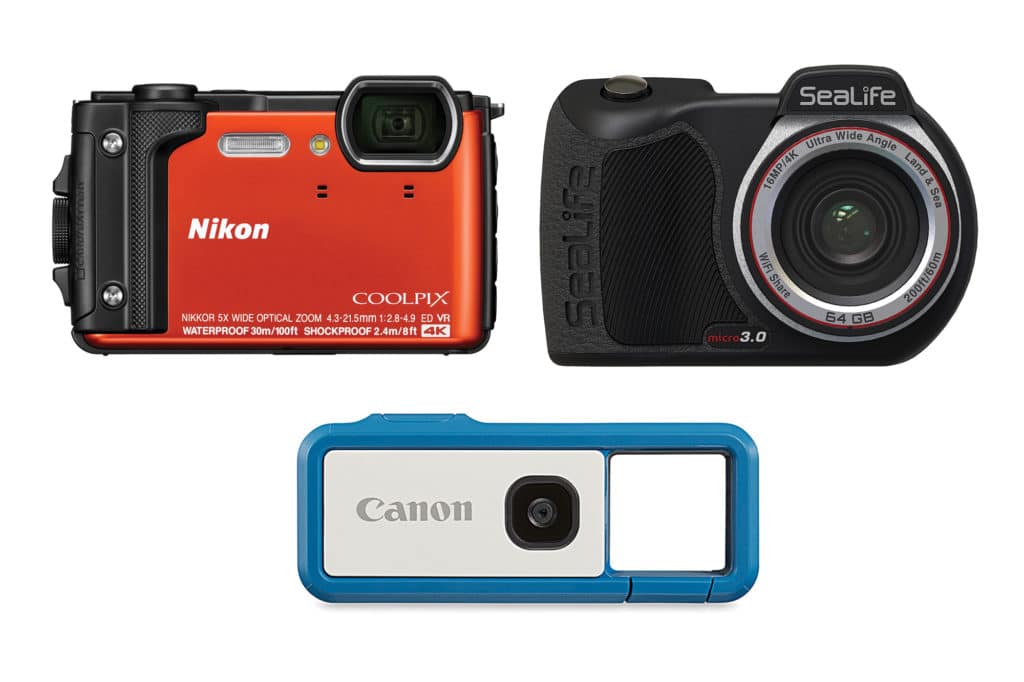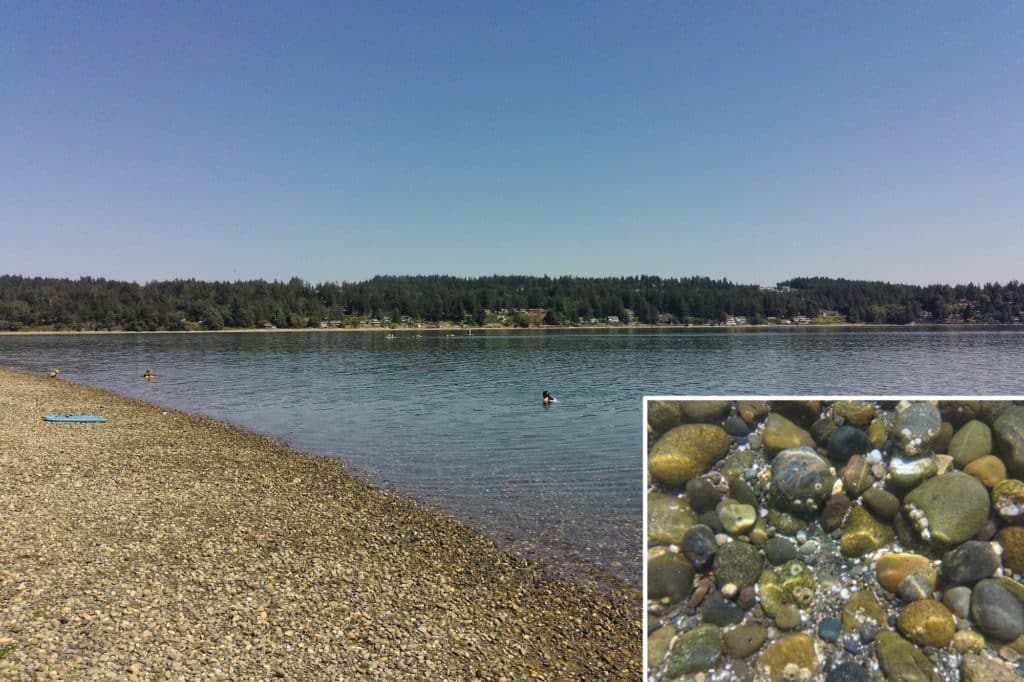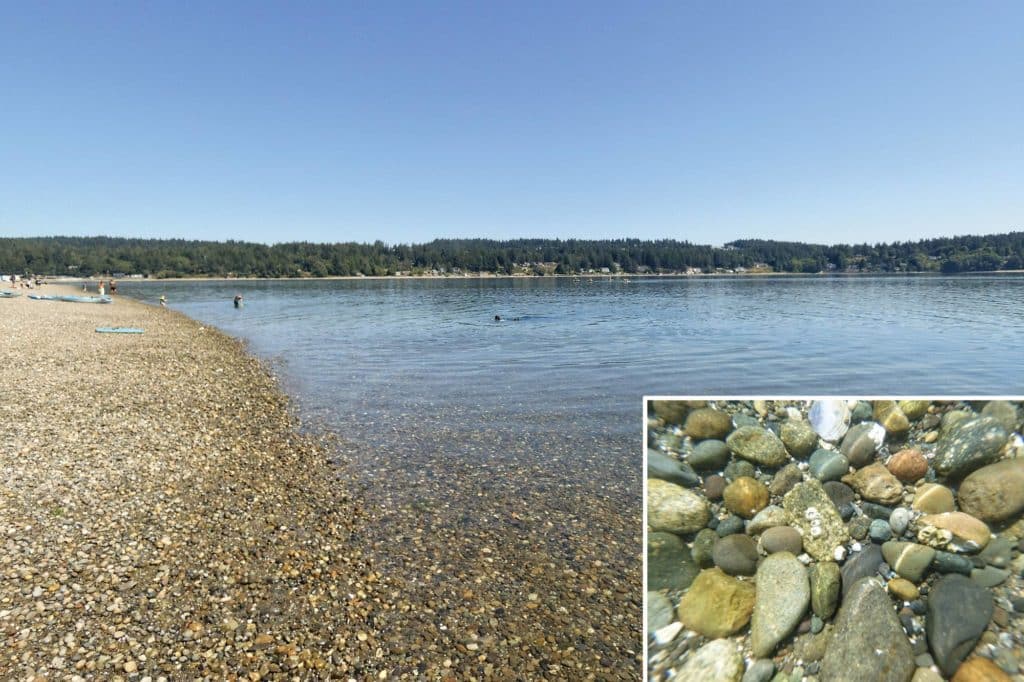
Sailing-friendly point-and-shoot cameras live challenging lives. Not only are they expected to be easy to use when things get hectic on deck, but they must also be able to capture sharp, rich images while tackling bright reflected light that can complicate metering. Moreover, they need to be as equally intuitive while exploring a new coastal town as they are while swimming off the transom or snorkeling with the family on a dream charter. Then there’s the matter of salt water, which doesn’t have a great reputation when mixed with sensitive electronics, and the inevitable bumps and bruises that are incurred when surprise waves send everything skittering across the cockpit sole. Here’s a look at some of the best pocket-size waterproof and water-resistant cameras available.

Canon Ivy Rec
I’ll admit that I wasn’t overly optimistic about the Canon Ivy Rec when it arrived. The camera features a colorful body (blue, green or pink; my tester was blue) and a carabiner-like clip that makes the 3-plus-ounce camera feel more like a toy than a serious shooting device. Then there’s the fact that the camera has no optical viewfinder or rear LCD screen for composing or reviewing shots, and that it’s good only to depths of 6-plus feet for 30 minutes.
My initial impression quickly shifted when I got home from my test shoots at a local beach and in a neighbor’s pool, downloaded the images onto my Mac, and viewed them on my high-definition monitor. That’s when my jaw dropped: The shots, given the camera’s tiny size, lightweight nature, and fetching price of $80 (usa.canon.com) were seriously impressive.
To be fair, I learned a critical pretrial trick about the camera from my wife, a reformed professional photographer, who pointed out that the camera’s square lanyard aperture (that’s protected by the carabiner-like gate) doubles as a hold-it-up-to-your-face viewfinder.
Regardless, the Canon Ivy Rec’s 13-megapixel sensor and 25.4-millimeter fixed lens consistently captured sharp-looking imagery that hit considerably harder than the camera’s featherweight price tag, both in salt water and in the pool. I was especially impressed with the Ivy Rec’s automatic light metering, ISO control (100 to 3200) and white-balance control, coupled with its capable lens.
User interface doesn’t get much simpler than the Ivy Rec, which features a single shutter-release button and a single thumb wheel, the latter of which allows users to select operating modes. These modes include wireless, photography, video and a hybridized multimode that captures a still image before switching to video mode. An LED light lets users know the camera’s status.
Images are stored on a microSD card (sold separately) and can be transferred using Canon’s Mini Cam app. Pairing and interfacing with the app was simple, as was transferring images to my iPhone. The included USB cable can be used to transfer data directly from the camera to a PC as well.
Field operations were as user-friendly as the Ivy Rec’s selector wheel and single-button interface. I especially appreciated the fact that the shutter-release button is tactilely discernible from the rest of the camera’s svelte body thanks to its raised profile and smooth finish. Even the mode-selection wheel was easy to adjust in the water because of its thumb-friendly tab.
While image composition was admittedly a bit less precise with the Ivy Rec than with a camera with an optical viewfinder or LCD screen, it did just fine, especially given the fact that it can accommodate up to a 256GB microSD card (in other words, that’s a whole lot of photos and videos).
So while I initially may have been skeptical of the Ivy Rec, the tiny Canon’s imagery quickly changed my way of thinking, especially for casual shooters, junior photographers-cum-crewmembers, and for trips ashore to places where it’s not the safest or smartest idea to tote a high-dollar camera.

Nikon CoolPix W300
Point-and-shoot waterproof digital cameras tread a fine line between being feature-rich and being overly complex, especially when one focuses on the underwater part of the equation, because it’s oftentimes trickier to adjust settings and dig into menu options when swimming, snorkeling or scuba diving. That said, I found that the Nikon CoolPix W300 nicely hits this balance, especially where image quality is concerned.
The camera is rated to 100 feet below the surface, and it delivers key features that are typically found on feature-rich terrestrial cameras. These include an f/2.8 Nikkor lens with a 5x optical zoom that delivers the equivalent performance of a 24-to-120-millimeter lens on a 35mm camera, a built-in flash, vibration reduction and a 3-inch LCD screen. Moreover, the camera is lightweight (8.2 ounces) and small (4.4-by-2.6-by-1.2 inches), making it easy to tote along for almost any activity. Also, for shooters who like to snap away during times when green water washes over the decks, the CoolPix is shockproof to drops of up to 8 feet.
The CoolPix W300 sports a 16-megapixel sensor that allows it to capture 4K ultra-high-definition video and high-definition (up to 4608-by-3456 pixels) still images. Users can select their desired photo and video resolutions from the camera’s intuitive menu system with just a few hard-button clicks.
The camera features built-in Wi-Fi and can share images with smart devices using Nikon’s SnapBridge app. And it has an embedded GPS, electronic compass, altimeter and Bluetooth low energy—allowing the camera to track your adventures. (For instance, cruisers can access their latitude and longitude from the camera’s menu, which is an added navigational benefit.)
Serious photographers can get creative with the CoolPix W300′s various special effects, while casual shooters can simply use the camera in its automatic mode, which is what I primarily employed during my field test. That said, it’s also easy to switch between beach, snow, landscape, and underwater shooting modes by pressing hard buttons and (firmly) tapping on the camera’s LCD screen.
In swimming, the CoolPix was easy to use, and its proportionately large LCD screen simplified image composition. The zoom was easy to find and operate, even with chlorine stinging my eyes, and the shutter release was easily discernable from the camera’s other buttons, which is a feature that’s great for shooting while snorkeling or diving.
Image quality was excellent, as one would expect from a Nikon. If I had to cite a downside, it would be the camera’s vertical grip, which I found to be small for my mitts. Overall I was impressed with the CoolPix W300, both in terms of its usability, size and weight, built-in feature set, and price tag of $390 (nikonusa.com).

SeaLife Micro 3.0
If you’re looking for a serious point-and-shoot underwater camera that can be used for a wide variety of adventures, SeaLife’s Micro 3.0 is a tough competitor to beat. For starters, the camera’s permanently sealed construction allows it to dive to depths up to 200 feet. Inherent in this construction method is that there’s no removable battery or memory card; in fact, the only thing that’s removable on the entire camera is a small rubber cover that protects the USB charging port. Inside its sealed body, the Micro 3.0 has a 2,000-milliamp lithium-ion battery that’s good for hours of shooting stills and video, 64GB of solid-state storage, and a Sony-built 16-megapixel sensor that can capture 4K ultra-HD video imagery.
While the Micro 3.0 is the largest and heaviest camera that I field-tested, I didn’t find its heft (11.6 ounces) or its girth (2.1-by-2.9-by-4.2 inches) to be drawbacks. The camera is encased in rubberized body armor, which bolsters its shock resistance. That said, I made sure to reeve the optional wrist strap because it provided a definite sense of security.
The first thing that I noticed about the Micro 3.0 were the simplicity of its design and user interface. The camera features a 2.4-inch color LCD display, and it has a total of four buttons—a shutter-release button and three piano-style hard keys: video, menu and playback. The Micro’s user interface is intuitive, and it took only a minute or three of pushing buttons to navigate around its operating system.
The Micro 3.0 has a fixed-focus lens that’s the equivalent of a 19mm, wide-angle lens on a 35mm camera, and it delivers a focus range that runs from 15 inches to infinity.
I found the Micro 3.0 to be easy to use on land, in salt water and in the pool. All of the piano-key buttons are where you’d want them to be; it was easy to discern the shutter-release button from the camera’s body (even in Puget Sound’s still-cold summertime water temperatures); and I also found the camera’s integral vertical grip to be ergonomic and useful for composing shots.
The camera boasts three underwater modes: dive, snorkel and underwater light; and three underwater color-correction modes: deep, shallow and green water, all of which are easy to access and adjust. The camera is Wi-Fi-enabled, and users can transfer images wirelessly using the SeaLifeMicro3+ app, or via an included USB cable. The camera is both Mac- and PC-friendly.
Overall I was impressed with the Micro 3.0, in terms of its ergonomics, user interface and image quality. I was able to choose from numerous resolution options, both for still imagery and video. While the Micro 3.0 is the most expensive camera in this roundup, selling for $600 (sealife-cameras.com), it would make a fine addition to any sailor’s sea bag, especially if underwater shooting is a big priority.
A Few Other Options
In addition to the point-and-shoot cameras manufacturers sent me so that I was able to use them in the field, my research turned up a few more possibilities to consider.
The Panasonic Lumix TS7 is designed to withstand drops from almost 7 feet and to endure loads up to 220 pounds, while also offering waterproof protection down to 102 feet. The camera comes with a 20.4-megapixel sensor that takes high-resolution stills and ultra-HD video, and its zooming capabilities deliver the equivalent of a 28-to-128-millimeter lens. com; $450)
The FujiFilm PinePix XP140 features a 16-megapixel sensor, a 5x optical zoom, and a lithium-ion battery that can take up to 240 images in between charges. The camera’s software features automatic subject recognition (it will autofocus on people’s eyes), multiple self-timer modes and the ability to capture up to 15 frames per second when operating in continuous-shooting mode. Cooler still, the camera’s companion app allows a smartphone to be used as a remote control. (fujifilm.com; $230)
If you’re seeking a distinct-looking camera that’s equally adept on board and ashore, check out Sony’s W800. Despite its urban-friendly styling, the W800 is waterproof, shockproof and X-ray-proof, and it can withstand temperature swings from minus 13 degrees Fahrenheit to 185 degrees. The W800 features a 20.1-megapixel sensor, a 5x optical zoom that’s further bolstered by a 40x digital zoom for taking still images, and a 10x digital zoom for video work. The camera’s scene-selection mode includes cruiser-friendly options—nighttime shooting and reflected light—and its SteadyShot Image Stabilization is purportedly great for times when the windward beat is fully self-descriptive. (sony.com; $100)
The Olympus Tough TG-6 might be a point-and-shoot camera, but its aftermarket accessories—optional telephoto and macro lenses, floating straps, and an underwater housing—allow shooters to stretch its comfort zone. Couple this with the camera’s 12-megapixel sensor, f/2 lens, and underwater shooting modes, and the Olympus Tough TG-6 is ready to go sailing. The TG-6 is waterproof to 50 feet; it’s built to absorb drops from 7 feet; and it features anti-fog glass. The camera can shoot ultra-HD 4K video, and its built-in Wi-Fi allows it to wirelessly share its imagery with paired smart devices. (olympus-global.com; $450)
Unlike the other point-and-shoot cameras featured in this article that are primarily aimed at capturing photographs but can also shoot video, the GoPro Hero8 inverts this equation, with video as its primary objective. That said, the Hero8 also captures high-resolution still images using its 12-megapixel sensor, and photographers can leverage the camera’s proprietary SuperPhoto and high-dynamic range capabilities. Also, the Hero8′s LiveBurst mode captures 3 seconds of video, from which users can either grab the best of 90 still images, or they can share this slice of time as a tiny 4K60 video. On the video side, the camera features three built-in microphones and noise-canceling technology that reduces the sound of wind, and its TimeWarp 2.0 feature allows videographers to slow down or speed up frame rates to create desired effects. The Hero8 recognizes 14 voice commands, a bonus for crew whose hands may be busy. The camera’s HyperSmooth 2.0 stabilization features gives users the ability to level the horizon using the GoPro app, which is key given the heel angles that are involved in sailing to weather. Cooler still, the Hero8 features four digital lenses: narrow, linear, wide and Super-View. These provide a ton of on-the-fly options. Finally, the GoPro is waterproof down to 33 feet, and is built to handle lumpy seas and overstuffed sea bags. (gopro.com; $450)
David Schmidt is CW’s electronics editor.








